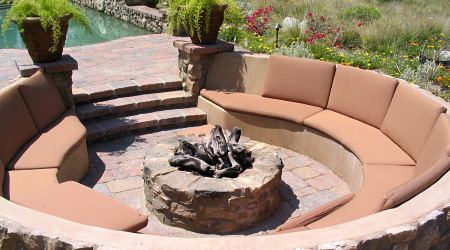Building a Fire Pit in the Back Yard

Since ancient times, man has been drawn to fire for food, warmth and comfort from the dark. That attraction is still going strong, and options for gathering round a backyard circle of dancing flames with family and friends are more numerous than ever.
Whether you're looking for a small, portable fire pit in the $100 range or a large, outdoor fireplace for $10,000 or more, you'll want to consider the full line of products available.
"It can be a daunting task for the homeowner to sort out," says Andy Wright, a landscape designer with Landworks, which works in the Kansas City, Mo., area. "The market is really evolving. We're on the verge of many possibilities."
Wright begins by asking clients how they entertain and what goals they have for the space. Are they trying to screen something? Do they want built-in seating? What is the budget?
Ron and Amy Mertz met with him about building an outdoor fireplace in their south Overland Park, Kan., yard.
First he helped them select a basic design using various widths and colors of pavers from a local hardscape company. Next the fireplace was constructed at a factory in Wisconsin. It was delivered by truck six weeks later in two pieces and assembled on a concrete pad in about two hours.
For the Mertz family, Wright suggested attached benches on either side of the fire box, but they could have chosen built-in wood-storage boxes, or mini-waterfalls flowing over the sides or a pizza oven.
While the modular construction is slightly cheaper than a fireplace constructed block by block (about 10 to 20 percent less, Wright says), the main attraction is the ease of installation. "The level of detail in this project would have taken lots of man hours to fabricate onsite," he says.
The fireplace was an immediate hit. "We went from never hanging out in the backyard to being outside every free weekend," Ron Mertz says. His children, under a watchful eye, use it frequently as well, and it has been the scene of many hot dog and s'mores parties. Mertz also likes the way the pavers tie in with the materials used for their patio, steps, walls and deck.
At another Overland Park home, Craig and Peggy Schwartz were considering purchasing a traditional fire pit when they noticed a fire boulder at a nearby model home. They were intrigued and thought it would add character to their yard.
Jared Barnes, a designer with Next to Nature Landscape, steered them to Canyon Stone in Olathe, Kan., to browse its selection of pre-drilled limestone and sandstone boulders. Cripple Creek Rock Co. in Kansas City also pre-drills boulders, specializing in granite.
"The main thing to consider with these is placement," Barnes says. "Once you plumb a gas line and set a 1,200-pound boulder, you don't want to move it."
He situated the rock at one end of the Schwartz's patio with a water feature behind it. At the other end, his crew used pavers to build a rectangular bar with a fire tray running along the middle. Gas flames flicker through smoky black glass beads, while the fire boulder holds lava rocks.
The unique combination has drawn the attention of neighbors, Peggy Schwartz says. "People are always coming by to see what's happening and saying how pretty everything looks. One guy who was driving by at night saw the flames and called up to say, "I think that bar is on fire!?" she says laughing.
While the Schwartz home has a custom-built fire bar, patio furniture stores often sell manufactured fire tables ranging from traditional to contemporary designs. At the upper price range - $1,200 to $2,500 - the tables feature granite tops and come in various heights: chat, dining and bar.
Some have interchangeable tops so the fire tray can be switched to a solid granite center with a small hole for an umbrella or a larger hole for an ice bucket. These tables can weigh up to 1,000 pounds, so again, placement is important.
For the smaller pocketbook, there are many inexpensive, lightweight choices for fire pits ranging from stainless steel and copper to ceramic and stone. For true portability, a wood-burning fire cart (with wood storage below) has wheels and a handle.
Another option, especially good for decks, is a faux stacked stone column with a small fire bowl attached on top. A disposable propane cylinder inside the column provides spark-free flames. These items usually retail for $100 to $350.
What's next in the world of fire? Wright is a big fan of fire-water combinations, now becoming popular in the Southwest. Such combinations include a stone bench encircling a fountain encircling a fire bowl, and fire pots perched along the edges of pools so the flames reflect in the water at night. There's also an inches-wide ground-level fire bar that curves halfway around a hot tub.
"I don't know if I'd recommend that one for my clients," he cautions. "You'd have to be careful where you step."
Still, whatever form the pairing takes, it's hard to top the tranquil sound and look of water juxtaposed with the flicker of red-hot flames, two of nature's most powerful elements. Whatever the market brings in the future, it seems likely that fire will continue to be a focal point in the home landscape.
"Everyone says they like the warmth it puts out, but that's not the main attraction," Wright says. "They really like the drama of watching the flames dance."
Elsewhere on StockMonkeys.com






